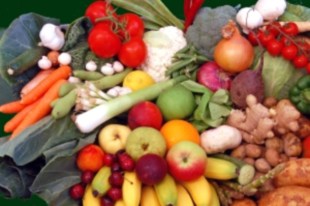Recently I had to review the dietary treatment of gout for a client. Gout is a common form of arthritis, yet there is very little research on the role of food despite textbooks and the web being full of dietary advice and presumptions.
What is gout?
Gout is characterized by high levels of uric acid in the blood (hyperuricaemia), and is more likely to occur in men than in women. The high levels of uric acid can trigger the deposition of sodium urate crystals in joints, causing intense pain.
Uric acid is an end-product compound from the breakdown of purines made within the body and consumed in the diet. Uric acid is normally eliminated via the kidneys so that uric acid stays at normal levels. High levels come from reduced elimination or an increased production. Some medications, such as those for high blood pressure, can also raise uric acid levels.
Gout has long been associated with overweight, binge eating and alcohol consumption. Losing weight and avoiding alcohol is common advice for many people with gout as this reduces the incidence of gout attacks. Beer consumption especially seems to crank up uric acid levels.
Forget common dietary advice
The most common and effective treatment for gout is through medication such as uricosuric drugs that increase the excretion of uric acid in your pee.
There has long been speculation that high purine foods are also a culprit in gout. Cutting out very high purine foods like offal, yeast extracts, sardines and anchovies may have an additional modest benefit with drug therapy, although dietary changes rarely lower serum uric acid by much more than 10%. There is now evidence that most purine-containing food, especially non-animal food, have little effect on uric acid levels.
Today, common food advice is still to avoid foods with modest levels of purine, such as peas, legumes, lentils, spinach, asparagus and mushrooms. It is not clear why spinach, asparagus and mushrooms are mentioned so frequently, as green peas, broccoli and Brussels sprouts have more purine yet I have never seen them mentioned once in a text book (and I have a few) or websites giving advice on gout.
Eat dairy, legumes, veggies and nuts
The truth is that foods such as dairy foods, possibly due to the dairy proteins, nuts, legumes and vegetables, even those with moderate purine content, seem to be protective against gout. A thorough review of the lifestyle evidence on gout risk states that those eating the most vegetables had a 27% reduced risk of gout compared to those eating the least (i.e. purine-rich vegetables were associated with a lower gout risk). Low fat dairy foods like milk and yogurt also reduce gout risk.
What does it all mean?
Sure, if you eat lots of sardines, offal, and kilos of meat every week then maybe you should cut back. Otherwise, just eat and drink healthy if you have gout. Lose weight if necessary. If you are a boozer, cut back to a maximum of two drinks a day. Cutting out specific purine-containing vegetables will have no benefit at all. In fact, you would be doing yourself a nutritional disservice.
And why is the big toe often the site of the first gout attack? The big toe is at the extremity of the body and generally a wee bit cooler than the rest of your body. Sodium urate crystallizes at cooler temperatures. When the pain hits, maybe put on a (second) pair of socks.
References:
Seminars Arthritis & Rheumatism 2008; 37: 243-250
Current Opinions in Rheumatology 2010; 22: 165-172
Last Reviewed 10/Mar/2014
Editor
Latest posts by Editor (see all)
- Oily fish and diabetes prevention - 04/06/20
- Manage the andropause - 11/12/17
- Testing testosterone levels - 07/12/17







